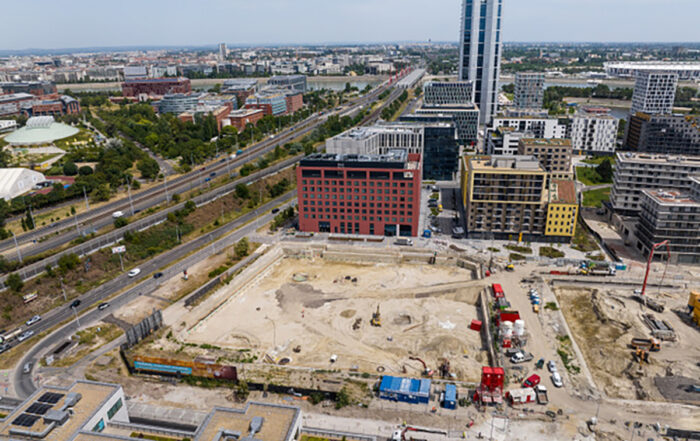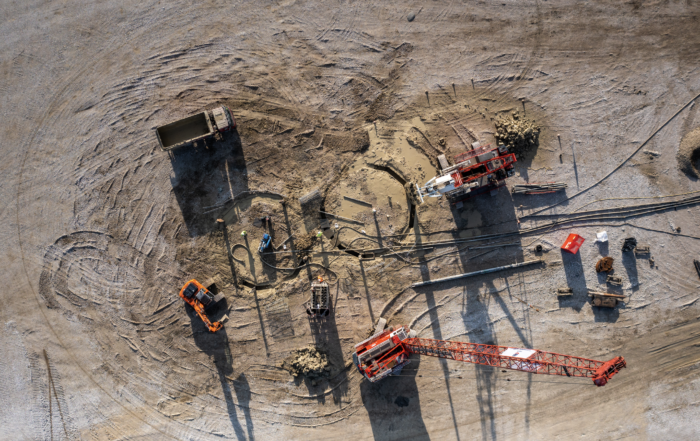Although civil engineering, as a special area of the construction industry, has a significant impact on the environment, this does not mean that it cannot be cultivated in a sustainable way. Accurate assessment of environmental impacts, savings through conscious design, and innovation-focused innovation can all lead to the emergence of new international standards in the industry.
Not only the economic significance, but also its environmental impact of the construction industry is becoming increasingly more important. HBM Soletanche Bachy, one of the international players in the sector with a presence in Hungary, has taken several important steps to improve the sustainability of its services and products. It has introduced new technologies and initiatives, worked more closely with key partners, collected, and analyzed data, and taken forward-looking steps to lower overall environmental impact. An environmentally friendly approach is also justified in this area of activity.
In our experience, environmental impact of the logistics behind special civil engineering is typically lower compared to architectural engineering, but due to the large amount of concrete with a high cement content, the specific carbon footprint of the material we use, is higher.
– Attila Szepesházi, head of technical department at HBM Soletanche Bachy, told Portfolio. He explained: “Civil engineering is more mechanized than architectural engineering, with machines of high-consumption, but at the same time we work with a smaller staff compared to other branches of the construction industry. The key areas of our sustainability efforts are low-carbon concrete and modern machines with lower environmental impact. We’re familiar with the areas of intervention, we know how to act effectively for sustainability. ”
Even saving is a great achievement
By its very nature, civil engineering, geotechnics, is an empirical industry, which is why the introduction of innovations requires a lot of preparation, investment, and the need to have partners who are confident in introducing innovations. Sustainability has started to become the focus of the civil engineering market in the last 1-2 years, but the actors are still seeking ways to take effective actions on this field.
IT IS IMPORTANT TO EMPHASIZE AT THE SAME TIME THAT SOMETHING CAN BE ENVIRONMENTALLY FRIENDLY JUST BY CHOOSING THE RIGHT DESIGN METHODS, THUS REDUCING MATERIAL CONSUMPTION – said Attila Szepesházi. Optimization during design also promises environmental results. The department head said:
THE ENTIRE SUPPLY CHAIN MUST BE MADE ENVIRONMENTALLY FRIENDLY SO WE CAN TALK ABOUT GREEN CONSTRUCTION. HBM CREATES THIS DEMAND WITHIN THE SUPPLY CHAIN.
Not all customers have a direct need for environmentally conscious construction, but the opportunity to do so is always welcomed. HBM is also working to acquire partners among contractors and investors for sustainable construction.
Assessment of impacts
One of the most important first steps in creating sustainability is knowing the impact of our activities on the environment. HBM has made it possible to measure CO2 emissions at its worksites to collect data to further improve its sustainability.
THE AVAILABLE DATA SHOULD PREDICT THE ESTIMATED CARBON DIOXIDE EMISSIONS FROM THEIR WORK AND, MOST IMPORTANTLY, SHOWS WHICH PART OF THE WORKS HAS THE STRONGEST IMPACT ON THE ENVIRONMENT.
This will help them develop better solutions to protect the environment. Based on their estimates, they have already optimized their work on the development of two factories in Eastern Hungary in 2021, set smart goals and made data-driven decisions to achieve our common carbon reduction goals with our customers.
AS A SPECIFIC RESULT, THE COMPANY SUCCESSFULLY IMPLEMENTED A WATER SAVING INITIATIVE DURING THE DEEP FOUNDATION WORKS OF A REAL ESTATE DEVELOPMENT PROJECT IN BUDAPEST.
Working on one of the most significant investments in the Hungarian real estate sector, the civil engineer company used water extracted from water wells established within the diaphragm wall instead of mains water. By using water from wells, a total of 90 kilograms of carbon dioxide could be saved. During the pilot program, HBM found the method to be effective and set a goal to use this method on its construction sites whenever possible in the future. Furthermore, depending on the water quality and conditions, they would like to meet the water needs of their other technologies with this or a similar alternative method.
Cooperation with higher education institutions
One of the most innovative steps in this field has been the application of polymer slurry in the past year. As part of the program, the civil engineering company used polymer slurry for the first time in Hungary for the construction of a diaphragm wall in one of its Debrecen projects. The technology has been introduced to reduce the environmental impact, as international practice has shown that the polymer slurry remaining after completion of the work can either be reused in a subsequent project or discharged into a public sewer and does not have to be disposed of as used bentonite slurry. The use of polymer slurry also reduces the environmental impact of transport, while the production of the technology alone is already more environmentally friendly than that of bentonite.
THE MATERIAL USED CAN BE RECYCLED SEVERAL TIMES AND THE NEED FOR MATERIALS IS SMALLER.
The introduction of the use of the solution has also helped the civil engineer to establish closer cooperation with the University of Debrecen, which has a key role in training of new professionals. The university has participated in laboratory studies to support the proper implementation of the technology in question.
Source: Portfolio
Photo: Getty Images



